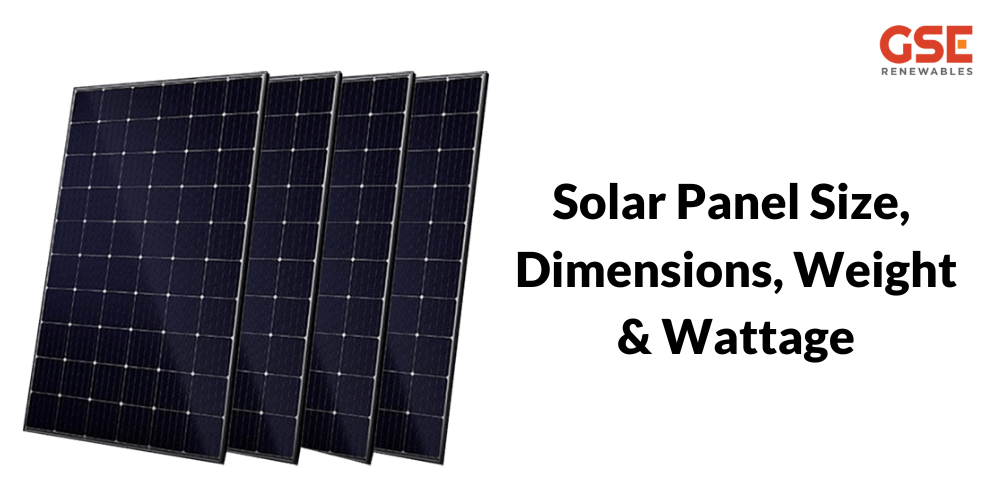Do Solar Panels Work on Rainy Days?
Jul 4

Looking to install solar panels for a business or industrial facility one of the most important factors to consider is the size of the solar panel required to meet your energy needs effectively. Commercial & industrial solar projects require careful assessment of energy consumption, available space & system efficiency. So it is important to understand solar panel dimensions & solar panel wattage prior to starting the installation process.
The physical dimensions of solar panels determine how many can fit on your available rooftop or ground area, while the wattage tells you how much power each panel can generate. Choosing the right balance between panel size & output ensures your solar system meets your energy needs cost-effectively.
In this blog, we will explain how businesses can assess the best panel sizes & wattage options for their commercial or industrial use, helping you make an informed, future-ready investment in solar energy.
When planning to install large scale commercial or industrial solar power plants typically ranging from 150 kW to 5 M, selecting the right solar panel size, dimensions & wattage is most important. Accurate planning ensures efficient use of space, optimal energy output, structural compatibility & cost effectiveness. The choice of panel layout directly affects system performance & long-term return on investment to successfully install solar panels as per your business needs.
Solar panel size refers to the power output (typically ranging between 450W and 600W per panel for commercial-grade modules) while solar panel dimensions refer to the physical height and width—usually around 2.1m x 1.1m for a standard 72-cell or 144 half-cut cell module.
In commercial & industrial solar projects, the size of solar panels affects how many can fit & calculates energy produced by the system. Choosing the right panel size is important to get the most energy from the space available, especially if the roof or ground area is limited. Bigger panels with higher wattage need fewer units, which lowers the cost of mounting, wiring, and installation work. This simpler setup improves system performance and helps you get faster returns with less maintenance in the long run.
Explore panel sizing & space requirements to install solar systems with capacity ranging from 150 kW to 5 MW for acquiring information about wattage, number of panels & area needed for efficient installation.
| Capacity | Avg Panel Wattage | No. of Panels | Approx Area Required |
| 150 kW | 500W | ~300 | ~660 m² |
| 500 kW | 500W | ~1,000 | ~2,200 m² |
| 1 MW | 550W | ~1,820 | ~4,000 m² |
| 5 MW | 600W | ~8,330 | ~18,000 m²+ |
Note: Actual area depends on layout (portrait/landscape), tilt angle, shadow buffer, and access clearance.
For commercial & industrial solar projects above 150 kW, the right combination of solar panel size, dimensions & wattage is crucial to ensure optimal performance. Whether you are developing a factory rooftop system, warehouse setup or a large ground-mounted solar plant, accurate sizing ensures better ROI, space utilization & long-term savings.
When investing in solar energy for your business, understanding the size of commercial solar panels is very important. They are designed for larger energy demands & broader roof spaces to improve system efficiency & return on investment.
To calculate the right solar power panel size for your business, follow these basic steps:
Step 1: Analyze Your Power Consumption
Step 2: Estimate Required System Capacity
Step 3: Calculate Number of Panels
Step 4: Calculate Total Area Required
The size of a commercial solar panel refers to two main aspects:
These larger, high-efficiency panels are designed to reduce the number of modules required for a given output, helping to cut installation time, structure costs & cabling.
In India, commercial solar panels generally adhere to global size & performance standards. However, the country’s unique climatic conditions such as intense heat, high dust levels & elevated humidity makes it essential to select panels that are suited for local environments. Businesses should prioritize models with a low temperature coefficient to ensure better efficiency during sunny days. Opting for Tier-1 solar panel brands that offer strong warranties and reliable after-sales service ensures long-term performance & peace of mind.
| Type | Configuration | Approx. Size (mm) | Power Output (W) | Use Case |
| Full-cell 72-cell | 6×12 | 2100 x 1100 | 415 – 460 W | Standard commercial & industrial roofs |
| Half-cell 144-cell | 6×24 | 2100 x 1040 – 1140 | 450 – 600 W | Larger commercial rooftops, solar farms |
| Bifacial commercial | Varies | Similar to above | 500 – 650 W (on both sides) | Ground-mounted projects or high-reflective rooftops |
To install an industrial solar rooftop system, it is essential to determine whether your roof is ready to support the installation. Since industrial solar panels are larger & heavier proper preparation is needed for safety, optimal performance & long life.
Assess Roof Condition:
Required Repairs and Upgrades:
Choosing Installation Location:
Permits and Compliance:
Solar Panel Selection:
Contact us today to install the right size solar rooftop system for your industrial facility.
Solar panel efficiency needs to be considered for large scale solar installations that are ranging from 150 kW to 5 MW. The efficiency of a solar panel directly impacts how much power it can generate per square meter in both the solar panel wattage & the total dimensions of the solar system.
In high capacity commercial & industrial solar projects, generating more energy with minimum required space is most important. Modern solar panels, especially monocrystalline ones now offer efficiencies between 19 & 22, a significant improvement over older technologies. It means that even panels with the same length and width can differ in wattage based on the technology used.
For instance:
To size your solar system correctly, divide the total system capacity (e.g., 500 kW) by the wattage of the selected panel:
Higher efficiency panels not only require fewer units but also optimize the length and width of solar panels required for available rooftop or land space.
Choosing high-efficiency solar panels is essential for large systems where space, performance, and ROI matter. By understanding the impact of panel efficiency on solar panel wattage & carefully calculating the dimensions of the solar system, you can optimize your commercial solar installation from 150 kW up to 5 MW.
For a detailed evaluation of panel layout, length and width of solar panels, and space requirements, consult with a commercial solar panel installation company.
| Wattage | Panel Dimensions (L x W) | Efficiency |
| 400W | ~2.0m x 1.0m | ~19% |
| 500W | ~2.1m x 1.05m | ~21% |
Understanding the relationship between your solar system capacity & its annual power generation is important for planning an efficient & cost effective solar installation. The total energy output of a solar system depends on multiple factors including its size (in kilowatts), the efficiency of the solar panels, geographic locatio & average solar irradiation (sunlight received per square meter per day).
| Solar System Capacity | Estimated Annual Power Output (kWh) |
| 150 kW | 210,000 – 240,000 |
| 250 kW | 350,000 – 400,000 |
| 500 kW | 700,000 – 800,000 |
| 1 MW | 1,400,000 – 1,600,000 |
| 2 MW | 2,800,000 – 3,200,000 |
| 5 MW | 7,000,000 – 8,000,000 |
These values are average estimates and can vary based on:
By evaluating your annual energy consumption and matching it with the right solar system size, you can accurately predict your solar ROI & reduce your dependency on grid power. For businesses and industries, this approach ensures better energy planning, cost savings & sustainability.
Looking to install solar panels for your commercial property? GSE makes it easy with our powerful Solar Calculator designed specifically to estimate the right size of the solar panel system your business needs. Whether you are running a retail outlet, factory, warehouse or office building knowing the solar power panel size that fits your energy consumption is essential for maximizing savings and energy efficiency. GSE Solar Calculator helps you determine the dimensions of the solar system required based on your actual power usage.
How It Works:
GSE Solar Calculator offers accurate sizing specifically for commercial rooftops, ensuring your solar installation matches your energy needs and available space. It is tailored to suit Indian weather and sunlight conditions, providing realistic and location-specific estimates. The tool supports a range of solar panel wattages & layout configurations, giving you flexibility in system design. Additionally, it helps you calculate the expected return on investment (ROI) allowing you to make informed decisions about your solar energy project.
For e.g. Whether you need a 50 kW system or a 5 MW solar setup, our tool helps you plan the most efficient layout using the optimal solar panel size and number of panels needed for your roof space.
To install solar power plants on roofs for commercial or industrial use, the weight of solar panels needs to be considered, which helps to make sure your roof can handle the load safely. Typically, a standard 60-cell solar panel weighs around 18 kg (40 pounds), while larger 72-cell commercial panels weigh approximately 23.5 kg (52 pounds). These larger panels are not only heavier but also taller to make them harder to lift and install especially on sloped or high rooftops. They also catch more wind during installation, so handling them carefully is important.
The solar panel weight can also change based on the brand, power output & type of material like monocrystalline or polycrystalline. This weight does not include the extra weight from mounting parts & frames which will also add to the total load on your roof. That’s why it is smart to get a professional to check your roof before installation.
Choosing the right panel weight makes the installation process easier, safer & more effective—especially in Indian weather conditions.
Solar panel size refers to both the physical dimensions length & width & the power output (wattage) of the panel. It matters because the size affects:
Key factors include:
A 60-cell commercial panel typically weighs around 18 kg (40 lbs). Weight can vary based on panel size, material & technology (monocrystalline vs. polycrystalline). Don’t forget to include the weight of mounting structures when assessing your roof’s load capacity.

Our Blogs With a combined experience of over 250 years and the successful management of 30 MW of solar energy projects, GSER offers the most efficient solutions. Do Solar Panels Work on Rainy Days? Solar energy is becoming an essential part of the modern energy...
Read MoreThe worldwide move to sustainable energy it is not just a trend its now adopting speed and RE100 (Renewable Energy 100%) ) is right at the heart of this corporate climate action.
Read MoreThe worldwide move to sustainable energy it is not just a trend its now adopting speed and RE100 (Renewable Energy 100%) ) is right at the heart of this corporate climate action.
Read More